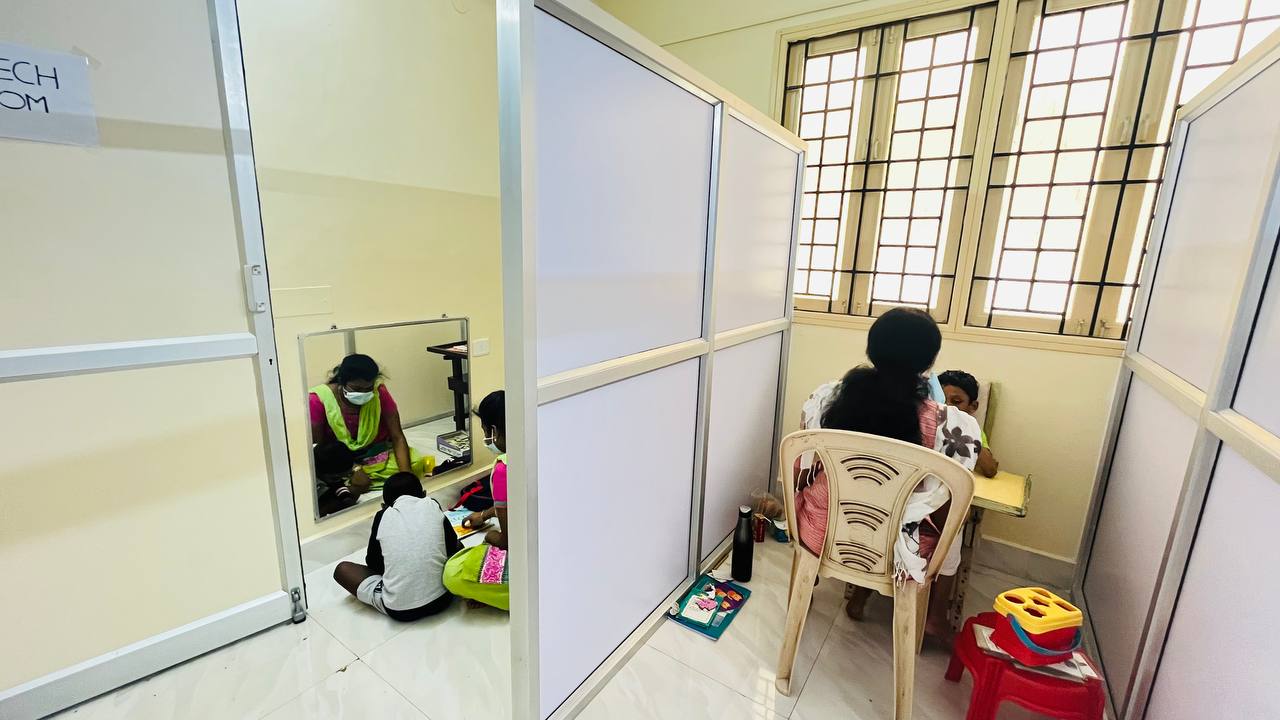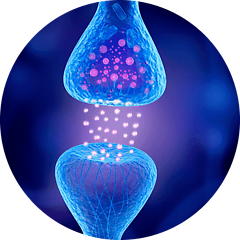
Speech is an expression or the ability to express thoughts and feelings by articulate sounds by
involving the precisely coordinated muscle actions of the tongue, lips, jaw, and vocal tract to
produce the recognizable sounds that make up language.
Language is a set of shared rules that allow people to express their ideas in a meaningful
way. Language may be expressed verbally or by writing, signing, or making other gestures,
such as eye blinking or mouth movements.
Voice is produced when air from the lungs passes through the vocal folds (vocal cords) in the
larynx (voice box) causing the vocal folds to vibrate.
Typically developing Speech and language milestones:
Like motor milestones, development of speech occurs through various stages of childhood.
Intensive period of speech and language development for humans is during the first three
years of life, that’s when the brain is developing and maturing.
There is increasing evidence suggesting that there are “critical periods” for speech and
language development in infants and young children. This means that the developing brain is
best able to absorb any language, during this period.
As healthcare practitioners, we emphasise early identification programme at modest. It is
identification of children with any developmental delay (less than 3 years) and to provide
intensive intervention at their earliest age, which in turn reduces the severity of the condition.
Following are the speech and language milestones observed across birth to two years of age.
By the end of 3 months
By the end of three months, your child might:
* Smile when you appear
* Make cooing sounds
* Quiet or smile when spoken to
* Seem to recognize your voice
* Cry differently for different needs
By the end of 6 months
By the end of six months, your child might:
* Make gurgling sounds when playing with you or left alone
* Babble and make a variety of sounds
* Use his or her voice to express pleasure and displeasure
* Move his or her eyes in the direction of sounds
* Respond to changes in the tone of your voice
* Notice that some toys make sounds
* Pay attention to music
By the end of 12 months
By the end of 12 months, your child might:
* Try imitating speech sounds
* Say a few words, such as “dada,” “mama” and “uh-oh”
* Understand simple instructions, such as “Come here”
* Recognize words for common items, such as “shoe”
* Turn and look in the direction of sounds
By the end of 18 months
By the end of 18 months, your child might:
* Recognize names of familiar people, objects and body parts
* Follow simple directions accompanied by gestures
* Say as many as 10 words
By the end of 24 months
By the end of 24 months, your child might:
* Use simple phrases, such as “more milk”
* Ask one- to two-word questions, such as “Go bye-bye?”
* Follow simple commands and understand simple questions
* Speak about 50 or more words
# Speak well enough to be understood at least half the time by you or other primary
caregivers
Conclusion:
Children who have trouble understanding what others say (receptive language) or difficulty
sharing their thoughts (expressive language) may have a language disorder. Specific language
impairment (SLI) is a language disorder that delays the mastery of language skills. Some
children with SLI may not begin to talk until their third or fourth year.
Children who have trouble producing speech sounds correctly or who hesitate or stutter when
talking may have a speech disorder. Apraxia of speech is a speech disorder that makes it
difficult to put sounds and syllables together in the correct order to form words.
However, its important to check on children hearing ability as its is an important sense, which
interrupts in speech and language development. Early identification of hearing loss eilds to
better outcome in their progress of life.
We SLPs, provide extensive counselling to the caregivers of the individual who require
assistance according to their needs. We even provide demonstrative therapy on training
parent as a primary therapist of the child and adults.
As Audiologist and Speech Language Pathologist we aid in improvising individual specific
rehabilitation with the above-mentioned disorders and condition. As a part of ‘team synapse’
we provide elaborative assessment and rehabilitation services across all age group in need of
speech, language, and voice deficits. We provide multidisciplinary team approach to enhance
individual’s overall wellbeing.
Pre- linguistic skills are the ways in which we communicate without using words and include
things such as gestures, facial expressions, social smile, joint attention, turn taking and eye-
contact. These are the skills that set children up to be ready to talk and communicate.
Receptive language refers to how the child understands language, comprehends lexical, body
parts, family members, follows directions etc.
Expressive language refers to how the child uses words, phrase, sentence to express by
himself/herself.
Young children with language difficulties may have:
* eye contact
* Difficulty interacting with other children
* A limited spoken vocabulary (less than 50 words at two years of age)
* Difficulty following directions (two-step directions at two years of age)
* Difficulty communicating wants and needs
Receptive language disorder- In this, the child has trouble understanding words that he or she
hears and reads.
Expressive language disorder- In this, the child has trouble speaking with others and
expressing thoughts and feelings. SLP will work on evaluation of the disorders, diagnosis,
early intervention, and counselling services. We SLP will use different age-appropriate
methods to help the child with language and communication. We SLP provide services on
improving social interaction, understanding of language and social communication. We SLP
provide services for following disorders such as Autism Spectrum Disorder, Attention Deficit
Hyperactive Disorder, Down Syndrome, Cerebral palsy, Intellectual Disability etc.
Stuttering:
Stuttering is more than just disfluencies. Stuttering also may include tension and negative
feelings about talking, avoid situations which involves talking etc.
Stuttering can change from day to day. Stress or excitement can lead to more stuttering.
People who stutter may have more disfluencies and different types of disfluencies. They may
repeat parts of words, stretch a sound out for a long time, or have a hard time getting a word
out.
Stuttering usually starts between 2 and 6 years of age. Many children go through normal
periods of disfluency lasting less than 6 months. Stuttering lasting longer than this may need
professional help in providing treatment.
There is no one cause of stuttering. Possible causes include the following:
# Family history, brain differences, gender, and age when stuttering began.
We SLP’s provide specific strategies to overcome stuttering and relative secondary
behaviours of stuttering.
Speech sound disorder:
This is an umbrella term referring to any difficulty or combination of difficulties with
perception, motor production, or phonological representation of speech sounds and speech
segments.
Speech sound disorders can be organic or functional in nature. Organic speech sound
disorders result from an underlying motor/neurological, structural, or sensory/perceptual
cause.
Functional speech sound disorders are idiopathic. Articulation and phonological disorder are
categorised under this. Among the organic cause, the most common condition observed is
cleft lip /palate (Structural origin).
The treatment varies depending upon the need, majorly it focuses on learning the correct way
to make sound, followed by telling sounds in different words. Finally, practicing the sounds
in longer sentences.
Voice disorders:
A voice disorder occurs when voice quality, pitch, and loudness differ or are inappropriate for
an individual’s age, gender. They are categorised as organic and functional.
Organic -These result from alterations in respiratory, laryngeal, or vocal tract mechanisms.
Further it is classified as:
# Structural – Usually caused from physical changes in the vocal mechanism,
such as alterations in vocal fold tissues (e.g., vocal nodules)
# Neurogenic -These results from problems with the central or peripheral
nervous system innervation to the larynx that affect functioning of the vocal
mechanism, (e.g., vocal tremor and vocal fold paralysis)
Functional -Voice disorders that result from inefficient use of the vocal mechanism when the
physical structure is normal, such as vocal fatigue, muscle tension dysphonia or aphonia.
SLPs plays a major role in the assessment, diagnosis, and treatment of voice disorders. The
treatment focuses on voice-producing mechanisms (phonation, respiration) by modifying the
vocal behaviours and to a establish healthy voice production.
Also, by modifying the cognitive, behavioural, psychological, and physical environments in
which voicing occurs to correct based on client’s requirement. Sometimes, few individuals
may require otolaryngologist help for surgical intervention.
Due to some medical condition such as dementia, stroke, right hemisphere brain injury,
traumatic brain injury, Laryngeal cancer, oral cancer adult may get acquired language and
speech disorder such as aphasia, dysarthria, apraxia, cognitive communicative disorder, and
dysphagia.
Aphasia:
Aphasia is adult language disorder which affects a person’s ability to express and understand
written and spoken language.
Dysarthria:
Dysarthria is a motor speech disorder in which the muscles that are used to produce speech
are damaged, paralyzed, or weakened. This weakness often causes slowed or slurred speech.
Apraxia:
Apraxia of speech (AOS) is a neurologic speech disorder that reflects an impaired capacity to
plan or program sensorimotor commands necessary for directing movements that result in
phonetically and prosodically normal speech.
Cognitive communicative disorder:
Cognitive-communication disorders are problems with communication that have an
underlying cause in a cognitive deficit rather than a primary language or speech deficit. This
results from impaired functioning of one or more cognitive processes.
Dysphagia:
Difficulty in swallowing is known as dysphagia. Dysphagia occurs when there is a problem
with the neural control, or the structures involved in any part of the swallowing process.
Role:
Speech Language pathologists evaluate and diagnose speech, language, cognitive-
communication, and swallowing disorders and treat individuals with speech, language and
swallowing disorder.

